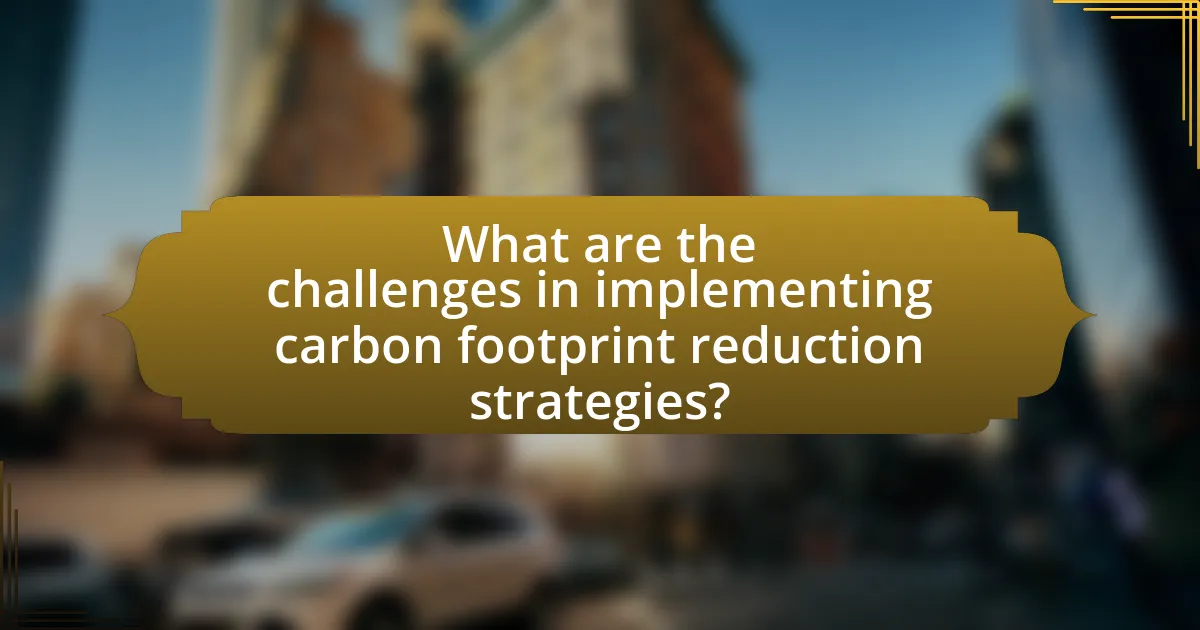The article focuses on strategies for minimizing the carbon footprint in structural projects, emphasizing the importance of sustainable materials, energy efficiency, and waste reduction practices. Key strategies include the use of recycled steel and low-carbon concrete, optimizing designs for energy efficiency, and implementing effective project management practices. The article also discusses the impact of material choices on carbon emissions, the role of energy-efficient designs, and the challenges faced in adopting sustainable practices. Additionally, it highlights the measurable outcomes of these strategies and their long-term benefits for environmental sustainability and cost savings in construction.

What are the key strategies for minimizing carbon footprint in structural projects?
Key strategies for minimizing carbon footprint in structural projects include using sustainable materials, optimizing design for energy efficiency, and implementing waste reduction practices. Sustainable materials, such as recycled steel and low-carbon concrete, significantly reduce emissions associated with production. Optimizing design through techniques like passive solar design and efficient insulation minimizes energy consumption during the building’s lifecycle. Additionally, waste reduction practices, including recycling construction debris and reducing material waste, further lower the overall carbon footprint. These strategies collectively contribute to a more sustainable construction process, aligning with global efforts to combat climate change.
How do material choices impact the carbon footprint of structural projects?
Material choices significantly impact the carbon footprint of structural projects by determining the amount of greenhouse gas emissions associated with the extraction, production, transportation, and disposal of materials. For instance, concrete and steel, commonly used in construction, have high embodied carbon due to energy-intensive manufacturing processes; concrete emits approximately 0.9 tons of CO2 per ton produced, while steel production can emit around 1.8 tons of CO2 per ton. In contrast, using sustainable materials like bamboo or recycled steel can substantially reduce emissions, as these alternatives often require less energy and generate lower carbon outputs. Additionally, the lifecycle assessment of materials reveals that sourcing locally can further minimize transportation emissions, contributing to a lower overall carbon footprint.
What are the most sustainable materials available for construction?
The most sustainable materials available for construction include bamboo, recycled steel, rammed earth, and reclaimed wood. Bamboo is a rapidly renewable resource that grows quickly and absorbs carbon dioxide, making it an eco-friendly choice. Recycled steel reduces the need for new steel production, which is energy-intensive, and can save up to 75% of the energy required to produce new steel. Rammed earth utilizes natural materials and has a low carbon footprint, while also providing excellent thermal mass. Reclaimed wood repurposes existing materials, reducing waste and the demand for new timber, thus conserving forests. These materials contribute significantly to minimizing the carbon footprint in structural projects by reducing resource consumption and promoting sustainability.
How does the lifecycle of materials affect carbon emissions?
The lifecycle of materials significantly affects carbon emissions through various stages, including extraction, production, transportation, use, and disposal. Each stage contributes to greenhouse gas emissions; for instance, the extraction and processing of raw materials often involve energy-intensive processes that release substantial carbon dioxide. According to the World Resources Institute, the production of cement alone accounts for approximately 8% of global carbon emissions, highlighting the impact of material choices in construction. Additionally, transportation of materials contributes to emissions based on distance and mode of transport, with longer distances typically resulting in higher emissions. The use phase can also influence emissions, particularly in energy consumption for heating or cooling buildings. Finally, the disposal stage, especially if materials are not recycled, can lead to further emissions through landfill methane production. Therefore, understanding and optimizing each phase of the material lifecycle is crucial for minimizing carbon emissions in structural projects.
What role does energy efficiency play in reducing carbon emissions?
Energy efficiency plays a crucial role in reducing carbon emissions by minimizing the amount of energy required for various processes, thereby decreasing the reliance on fossil fuels. When buildings and infrastructure are designed to use less energy, they directly lower the emissions associated with energy production. For instance, according to the International Energy Agency, improving energy efficiency in buildings can reduce energy consumption by up to 50%, which significantly cuts carbon emissions. This reduction is essential for meeting global climate targets, as the building sector alone accounts for nearly 40% of total energy-related carbon emissions.
How can energy-efficient designs be implemented in structural projects?
Energy-efficient designs can be implemented in structural projects by integrating sustainable materials, optimizing building orientation, and utilizing advanced energy systems. Sustainable materials, such as recycled steel and low-emission concrete, reduce the carbon footprint during construction. Optimizing building orientation maximizes natural light and ventilation, which decreases reliance on artificial lighting and HVAC systems. Advanced energy systems, including solar panels and energy-efficient HVAC units, further enhance energy performance. According to the U.S. Green Building Council, buildings designed with energy efficiency in mind can reduce energy consumption by 30-50%, demonstrating the effectiveness of these strategies in minimizing carbon footprints.
What technologies enhance energy efficiency in construction?
Technologies that enhance energy efficiency in construction include advanced building materials, energy management systems, and renewable energy integration. Advanced building materials, such as insulated concrete forms and energy-efficient windows, significantly reduce thermal loss, leading to lower energy consumption. Energy management systems optimize the use of energy in buildings by monitoring and controlling heating, cooling, and lighting, which can reduce energy use by up to 30%. Additionally, integrating renewable energy sources, like solar panels and wind turbines, allows buildings to generate their own energy, further decreasing reliance on fossil fuels and minimizing carbon footprints. These technologies collectively contribute to more sustainable construction practices.
How can project management practices contribute to a lower carbon footprint?
Project management practices can contribute to a lower carbon footprint by optimizing resource allocation, enhancing efficiency, and promoting sustainable practices throughout the project lifecycle. By implementing methodologies such as Agile or Lean, project managers can minimize waste and reduce energy consumption, leading to lower emissions. For instance, a study by the Project Management Institute found that effective project management can reduce project costs by up to 30%, which often correlates with reduced resource use and emissions. Additionally, incorporating sustainability assessments in the planning phase allows for the selection of eco-friendly materials and technologies, further decreasing the carbon footprint of structural projects.
What are the best practices for sustainable project management?
The best practices for sustainable project management include integrating sustainability into the project lifecycle, engaging stakeholders, and utilizing eco-friendly materials. Integrating sustainability means considering environmental impacts from project initiation through completion, ensuring that decisions align with sustainability goals. Engaging stakeholders involves collaborating with all parties affected by the project, which fosters transparency and encourages sustainable practices. Utilizing eco-friendly materials reduces the carbon footprint and promotes resource efficiency, as evidenced by studies showing that projects using sustainable materials can lower emissions by up to 30%. These practices collectively enhance project outcomes while minimizing environmental impact.
How can stakeholder engagement influence carbon reduction strategies?
Stakeholder engagement significantly influences carbon reduction strategies by fostering collaboration and ensuring diverse perspectives are considered in decision-making processes. Engaging stakeholders, such as local communities, businesses, and environmental organizations, leads to the identification of innovative solutions and best practices tailored to specific contexts. For instance, a study by the International Institute for Environment and Development found that projects with active stakeholder participation achieved 30% greater emissions reductions compared to those without such engagement. This collaborative approach not only enhances the effectiveness of carbon reduction initiatives but also builds trust and accountability among stakeholders, ultimately leading to more sustainable outcomes in structural projects.

What are the challenges in implementing carbon footprint reduction strategies?
Implementing carbon footprint reduction strategies faces several challenges, including financial constraints, technological limitations, and stakeholder resistance. Financial constraints often arise from the high initial costs associated with adopting new technologies or processes aimed at reducing emissions. For instance, a study by the International Energy Agency indicates that transitioning to renewable energy sources can require significant upfront investment, which may deter organizations from pursuing these strategies.
Technological limitations also pose a challenge, as not all regions have access to the latest carbon-reducing technologies, and existing infrastructure may not support the necessary changes. Additionally, stakeholder resistance can stem from a lack of awareness or understanding of the benefits of carbon reduction, leading to pushback from employees, management, or the community. Research published in the Journal of Cleaner Production highlights that effective communication and education are crucial in overcoming this resistance and facilitating the adoption of carbon reduction initiatives.
What barriers do construction projects face in adopting sustainable practices?
Construction projects face several barriers in adopting sustainable practices, including high initial costs, lack of skilled labor, and insufficient regulatory support. High initial costs deter many stakeholders from investing in sustainable materials and technologies, as they often perceive them as financially burdensome despite long-term savings. The lack of skilled labor trained in sustainable practices limits the implementation of innovative techniques and materials, hindering project efficiency and effectiveness. Additionally, insufficient regulatory support creates an environment where sustainable practices are not incentivized, leading to a preference for traditional methods that may not prioritize environmental considerations. These barriers collectively impede the widespread adoption of sustainability in the construction industry.
How do financial constraints impact the choice of sustainable materials?
Financial constraints significantly limit the selection of sustainable materials in structural projects. When budgets are tight, decision-makers often prioritize cost over environmental benefits, leading to the use of cheaper, less sustainable options. For instance, a study by the World Economic Forum indicates that 70% of construction projects face budget overruns, which can compel stakeholders to opt for conventional materials that may not meet sustainability criteria. Consequently, financial limitations can hinder the adoption of innovative, eco-friendly materials that typically require higher initial investments but offer long-term environmental advantages.
What regulatory challenges exist for carbon footprint reduction in construction?
Regulatory challenges for carbon footprint reduction in construction include inconsistent standards, lack of enforcement mechanisms, and insufficient incentives for sustainable practices. Inconsistent standards arise from varying regulations across regions, leading to confusion and compliance difficulties for construction firms. Lack of enforcement mechanisms means that even existing regulations may not be effectively implemented, allowing non-compliance to persist. Additionally, insufficient incentives, such as tax breaks or grants for adopting low-carbon technologies, hinder the motivation for companies to invest in sustainable practices. These challenges collectively impede progress toward reducing carbon emissions in the construction sector.
How can these challenges be overcome?
To overcome challenges in minimizing carbon footprint in structural projects, implementing sustainable design practices is essential. This includes utilizing energy-efficient materials, optimizing building orientation for natural light, and incorporating renewable energy sources such as solar panels. Research indicates that buildings designed with these strategies can reduce energy consumption by up to 30% (U.S. Department of Energy, 2020). Additionally, adopting life cycle assessment (LCA) tools allows project teams to evaluate the environmental impact of materials and construction methods, leading to more informed decisions that lower carbon emissions. By integrating these approaches, structural projects can effectively address and mitigate the challenges associated with carbon footprint reduction.
What innovative solutions are being developed to address these barriers?
Innovative solutions being developed to address barriers in minimizing carbon footprints in structural projects include the use of carbon capture and storage (CCS) technologies, which can significantly reduce emissions from construction processes. For instance, companies are integrating bio-based materials, such as cross-laminated timber, which sequester carbon and reduce reliance on traditional concrete. Additionally, advancements in modular construction techniques allow for reduced waste and improved energy efficiency during building assembly. Research from the International Energy Agency indicates that implementing these technologies can lead to a 20-30% reduction in carbon emissions in the construction sector.
How can collaboration among stakeholders facilitate change?
Collaboration among stakeholders can facilitate change by fostering shared goals and resources, which enhances the effectiveness of strategies aimed at minimizing carbon footprints in structural projects. When stakeholders, including architects, engineers, contractors, and clients, work together, they can align their objectives, share innovative practices, and implement sustainable technologies more efficiently. For instance, a study by the World Green Building Council found that collaborative approaches in construction projects can lead to a 30% reduction in carbon emissions through optimized resource use and improved design processes. This evidence illustrates that stakeholder collaboration not only accelerates the adoption of eco-friendly practices but also drives systemic change in the industry.

What are the measurable outcomes of implementing these strategies?
The measurable outcomes of implementing strategies for minimizing carbon footprint in structural projects include reduced greenhouse gas emissions, lower energy consumption, and enhanced material efficiency. For instance, adopting sustainable materials can lead to a 30% reduction in carbon emissions, as evidenced by a study from the University of Cambridge, which found that using recycled materials in construction significantly lowers the overall carbon footprint. Additionally, energy-efficient designs can decrease operational energy use by up to 50%, according to the U.S. Department of Energy. These outcomes not only contribute to environmental sustainability but also result in cost savings over the lifecycle of the project.
How can the effectiveness of carbon reduction strategies be assessed?
The effectiveness of carbon reduction strategies can be assessed through quantitative metrics such as carbon footprint analysis, lifecycle assessments, and emissions tracking. Carbon footprint analysis measures the total greenhouse gas emissions associated with a project, providing a clear numerical value that reflects the impact of implemented strategies. Lifecycle assessments evaluate the environmental impacts of a project from inception to disposal, allowing for a comprehensive understanding of carbon emissions over time. Emissions tracking involves monitoring and reporting actual emissions against projected reductions, ensuring accountability and transparency. These methods are supported by data from organizations like the Intergovernmental Panel on Climate Change, which emphasizes the importance of measurable outcomes in evaluating climate strategies.
What metrics are used to evaluate carbon footprint in structural projects?
Metrics used to evaluate carbon footprint in structural projects include embodied carbon, operational carbon, and lifecycle carbon emissions. Embodied carbon measures the total greenhouse gas emissions associated with the materials and construction processes, while operational carbon accounts for emissions during the building’s use phase, such as energy consumption. Lifecycle carbon emissions encompass both embodied and operational carbon, providing a comprehensive view of a project’s total carbon impact over its entire lifespan. These metrics are essential for assessing and minimizing the environmental impact of structural projects, as they guide decision-making in material selection and energy efficiency strategies.
How do these metrics inform future project decisions?
Metrics related to carbon footprint in structural projects inform future project decisions by providing quantifiable data that highlights the environmental impact of various design and construction choices. For instance, metrics such as embodied carbon, energy consumption, and waste generation allow project managers to evaluate the sustainability of materials and methods used. By analyzing these metrics, decision-makers can identify high-impact areas for improvement, such as selecting low-carbon materials or optimizing energy efficiency, which can lead to reduced emissions in future projects. Research indicates that projects utilizing carbon metrics can achieve up to a 30% reduction in overall carbon emissions, demonstrating the effectiveness of data-driven decision-making in enhancing sustainability outcomes.
What are the long-term benefits of minimizing carbon footprint in structural projects?
Minimizing carbon footprint in structural projects leads to significant long-term benefits, including reduced environmental impact, cost savings, and enhanced sustainability. By lowering greenhouse gas emissions, projects contribute to climate change mitigation, which is crucial as the construction sector accounts for approximately 39% of global carbon emissions, according to the Global Alliance for Buildings and Construction. Additionally, energy-efficient designs and materials can lead to lower operational costs over time, as buildings consume less energy. Furthermore, sustainable practices can improve a project’s marketability and compliance with increasingly stringent regulations, fostering a positive public image and attracting environmentally conscious investors.
How does reducing carbon emissions impact project costs over time?
Reducing carbon emissions generally leads to lower project costs over time due to decreased energy consumption and potential regulatory incentives. Projects that implement energy-efficient technologies and sustainable materials often experience reduced operational costs, as these measures lower energy bills and maintenance expenses. For instance, a study by the International Energy Agency found that energy-efficient buildings can save up to 30% on energy costs compared to traditional structures. Additionally, as governments increasingly impose carbon taxes or offer subsidies for sustainable practices, projects that prioritize emissions reduction may benefit financially from these incentives, further decreasing overall costs.
What are the environmental benefits of sustainable construction practices?
Sustainable construction practices significantly reduce environmental impact by minimizing resource consumption and waste generation. These practices often utilize renewable materials, which lowers the carbon footprint associated with extraction and processing. For instance, buildings designed with energy-efficient systems can reduce energy consumption by up to 30%, as reported by the U.S. Department of Energy. Additionally, sustainable construction promotes the use of recycled materials, which diverts waste from landfills and conserves natural resources. According to the World Green Building Council, green buildings can reduce water usage by 40% and energy usage by 30-50%, contributing to overall environmental sustainability.
What practical tips can be applied to minimize carbon footprint in structural projects?
To minimize carbon footprint in structural projects, implement strategies such as using sustainable materials, optimizing design for energy efficiency, and incorporating renewable energy sources. Sustainable materials, like recycled steel or bamboo, significantly reduce emissions associated with production. Optimizing design can lower energy consumption during the building’s lifecycle; for instance, passive solar design can reduce heating and cooling needs by up to 50%. Additionally, integrating renewable energy sources, such as solar panels, can offset operational emissions, contributing to a lower overall carbon footprint.

Leave a Reply